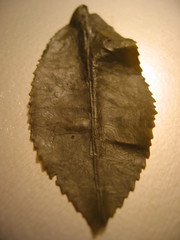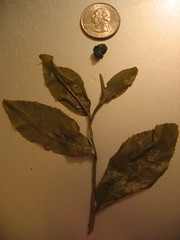

Photos by Ben Kaminsky
Left: a photo of a single unfurled leaf. Right: A quarter next to a rolled/unbrewed tea pearl with a brewed unfurled intact leaf/stem underneath.
Leaf appearance is a critical observation when judging the quality of a tea. Just like green coffee to a certain extent, you can judge the quality and the degree of precision in processing just by looking at the leaf. In China and Taiwan, the teas are sometimes named after their dried leaf appearance. In many cases, the leaf appearance cannot tell you exactly what kind of flavor it has, but it can certainly tell you all about the processing, and from knowledge of the processing you should be able to tell where the flavor is coming from. According to the Tea Research and Extension station in Yangmei Taiwan, “As a matter of fact, it is a good quality tea, as long as it looks good.” The idea behind this theory is that the people who are judging the tea train themselves to detect flaws in appearance that parallel those in taste.
When judging a tea by leaf appearance, one must look for several things. In the dry leaf, consistency, degree of oxidation, and roast or firing is evident. Also the skill with which the tea was handled and sorted is evident by the shape and consistency in size. The post steeped leaf can tell you how consistant the grading was and reveal flaws in the oxidation.
For example, things I look for in a Semi-ball type Poachong tea (the tea in the photo) are consistency in size, shape and color. The color tells you how heavy the oxidation and roast are. Size and shape tell you how well sorted the tea was, and also how the leaves were manipulated in the processing. In the wet leaf(after it is steeped), I look for evenness of oxidation, color, and how intact the leaf structure remains. A good semi-ball paochong should have very few broken particles when brewed and for the most part, the leaves should stay intact through the duration of the steepings. If the oolong leaf shows too much brown, this is a sign of too much oxidation and is contributing to the bitterness and astringency of the tea.
Judging what a tea should look like is different with each tea, and should be judged according to what the tea manufacturer was trying to get. In the end, cupping a tea's taste is the deciding factor, but leaf appearance helps explain how and why the tea tastes a certain way.
-Silas
Also see:
Tea: Processing
Cupping high grade taiwanese teas
